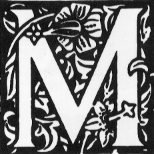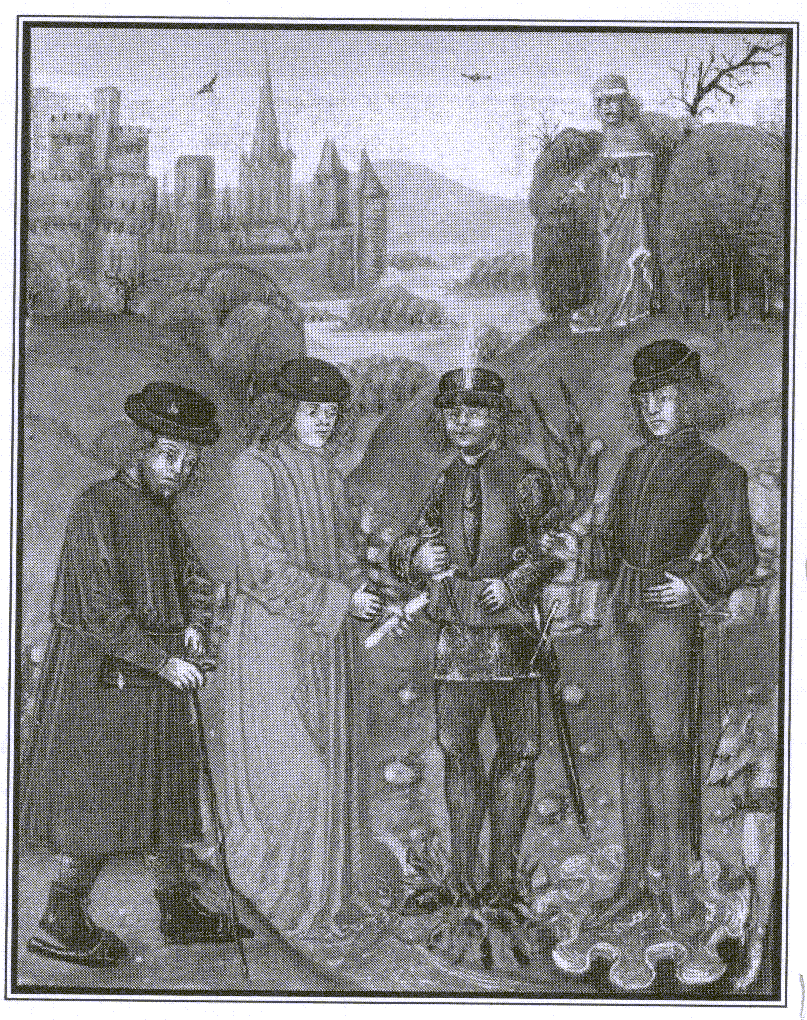
|
Medieval Medical Regimen
A Work In Progress
by Sofya la Rus, Mka Lisa Kies

| |
Updated 17 June 2007
Introduction:
Lifestyle was considered a critical determinant of health, perhaps more so than today. And it was often ignored by the patient, much like today.
As with the rest of medieval medical practice, a healthly lifestyle or regimen was based on an understanding of the four elements and the four humors.
All things in the world are composed of four elements:
- Air – hot and moist
- Fire – hot and dry
- Earth – cold and dry
- Water – cold and wet
The proportion of these elements in each object determines its nature.
In the human body the four elements correspond to the four humors:
- Air – hot and moist - Blood
- Fire – hot and dry – Yellow bile or choler
- Earth – cold and dry – black bile or melancholy
- Water – cold and wet - phlegm
The proportion of these humors in each person determines their physical and mental tendencies.

The medieval temperaments:
Sanguine
The life of the party – charming, talkative and cheerful
Does not worry much about the future.
Some authorities consider the ideal temperament.
Prone to headaches, swelling, gaining weight, fevers with sweats, diarrhea.
Closest Meyers-Briggs Type - ESFP
Choleric
A natural leader – bold, focused and ambitious.
Quick to anger.
Reddish complexion
Tends to stomach ailments, liver troubles, dry skin, sunburns, dry fevers.
Closest Meyers-Briggs Type - ENTJ
Phlegmatic
The peacelover.
Quiet, calm, never gets upset, avoids change, prone to day-dreaming.
Fair skin, short stature.
Susceptible to lung problems, excess mucus, weight gain, kidney problems.
Closest Meyers-Briggs Type - ISFP
Melancholy
The scholar.
Solitary and studious. Detail oriented and loves abstract theory.
Dark/sallow complexion
Prone to depression, constipation.
Closest Meyers-Briggs Type - INTJ
Link to temperament test here...
Age and the Humors:
Childhood = warm and moist time of life - more sanguine, less melancholy
Youth = warm and dry time of life - more choleric, less phlegmatic
Adulthood = cool and dry time of life - more melancholy, less sanguine
Old age = cool and moist time of life - more phlegmatic, less choleric
Seasons and the Humors:
Spring = warm and moist time of year - more sanguine, less melancholy
Summer = warm and dry time of year - more choleric, less phlegmatic
Fall = cool and dry time of year - more melancholy, less sanguine
Winter = cool and moist time of year - more flegmatic, less choleric
Other Influences on Health:
The environment and weather - winds, sun, moisture, bad air
Activity - sleep, bathing and hygiene, exercise, work, sexual activity
Emotions - anger, laughter, grief
Diet
Trauma
The above all interact. So a person with sanguine temperament (warm and moist) will be healthier in the fall (cool and dry) and in middle age (also cool and dry), but must be extra careful in the spring and in childhood when their temperamental tendency to excess blood is enhanced by the time of year and time of life.
Illness is caused by:
Deficient humor/s
Excessive humor/s
Defective/putrefying humor/s
These problems are caused when environment, emotions, activity, etc. alter the healthy balance of humors in the body.
General principles of a healthy lifestyle:
Any sudden change in lifestyle or environment is dangerous.
Avoid things that could make you sick. Your medieval “allergies” start with things that are bad for your temperament. For example, someone who has a tendency to an excess of choler, a choleric temperament, should avoid choleric (hot and dry) things.
Choose things to counteract your temperament. Our choleric friend should generally try to eat cool and moist (phlegmatic) foods.
Maintain balance. When exposed to hot, wet weather, one should eat cooling and drying foods to maintain the balance of humors in the body. (While keeping in mind your temperament and age.)
Diagnosing Illness:
Determine recent exposures (weather, diet, etc.)
Analyse symptoms (for example, moist vs. dry fever)
Evaluate bodily secretions (for example, yellow vs. white vs. bloody nasal discharge)
Treat the Imbalance:
Increase the humor that is lacking through diet, activity, medicines, etc.
Decrease the humor that is defective or excessive through sweating, purging, bloodletting, etc.
Heating and moisturizing things (encourage formation of good blood):
Foods – Poultry, mutton, veal, onion, celery, eggplant, turnips, dates, figs, grapes, butter, etc.
Beverages – hot water,
Herbs – licorice, nutmeg (or dry?), watercress
Environment – south wind
Heating and drying things (for formation of yellow bile or choler):
Foods – beef, dried/salted meats, roasts, roosters, beet, cabbage, leeks, dried figs, sweet dates, almonds
Beverages – wine, rose water, salt water, ale?
Herbs – anise, basil, mustard, parsley, pepper, mint
Environment – silk or woolen clothes
Cooling and drying things (improve black bile):
Foods – fish, gelatin, lemons, citrons, black cherries, sour apples, cheese, vinegar, barley, millet, rye, rice
Herbs – betony, camphor, plantain
Environment – linen clothing, north wind, long baths
Cooling and moisturizing things (increase phlegm):
Foods – duck and geese, pork, prawns, chick peas, cucumbers, lettuce, cherries, melons, watermelon
Herbs – borage, purslane, licorice (or hot?)
Activities – snow and ice, short baths
A Quiz:
In accordance with humors...
References:
Culpeper’s The Complete Herbal.
de Lanvallei, Agnes. “On Humors” Class Handout June 2005, Lilies War XIX.
Getz, Faye M. Healing and society in Medieval England: a Middle English
translation of the pharmaceutical writing of Gilbertus Anglicus.
University of Wisconsin Press, 1991.
Getz, Faye M. Medicine in the English Middle Ages Princeton
University Press. 1998.
Gottfried, Robert S. Doctors and medicine in medieval England,
1340-1530. Princeton University Press, 1986.
Jones, Peter M. Medieval medical miniatures. British Library with
Wellcome Institute. 1984.
Macer, Floridus. A Middle English translation of Macer Floridus De
viribus herbarum. Harvard University Press, 1949.
Prescott, Elizabeth. The English medieval hospital, c. 1050-1640.
Seaby, 1992.
Rawcliffe, Carole. Medicine & society in later medieval England
A. Sutton, 1995.
Regiment sanitatis Salernitanum. Ente Provinciale per il Turismo.
1966?
Talbot, Charles H. Medicine in medieval England. Oldbourne,
1967.
Unani Medicine. www.unani.com (based on Avicenna’s Cannon of Medicine).
Walsh, James J. Medieval medicine. A. & C. Black, 1920.
Back to Medieval Materials.




